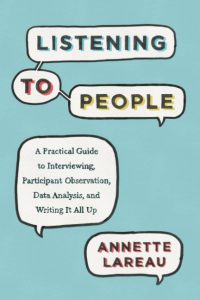In Listening to People: A Practical Guide to Interviewing, Participant Observation, Data Analysis, and Writing It All Up, Annette Lareau provides insight into the practicalities of interview-based research and participation observation. This is an excellent and exciting guide that offers useful recommendations to researchers before they land in the field, writes M. Kerem Coban.
Listening to People: A Practical Guide to Interviewing, Participant Observation, Data Analysis, and Writing It All Up. Annette Lareau. Chicago University Press. 2021.
 Find this book (affiliate link):
Find this book (affiliate link):![]()
In the introductory chapter of Interview Research in Political Science, Layna Mosley mentions her experience during her doctoral studies. She does not know where to start her interview-based research, which questions to ask, how to enter the site, how to collect data or how to analyse it. Her supervisor advises that she will ‘just talk to people’. Her puzzle will sound familiar to many of us. After reading Mosley’s edited volume and other books, I was still unsure how to implement their suggestions.
Many students grapple with similar challenges. Listening to People can be the ‘bible’ for the practicalities of interview-based research and participant observation. The book covers various dimensions a beginner might not have imagined before. In my own case, my memories about failures or precautionary acts flashed as I turned the pages. Still, rather than making it up as I went along, I could have begun my journey by equipping myself with Annette Lareau’s recommendations, because the book shows you the pitfalls and how to prepare yourself before landing in the field. You will even find a list of items you’d better carry in your interview bag, including protein bars. Such details do not exist in most qualitative research methods textbooks, let alone research methods courses. At the same time, the book makes a compelling case for interview research and participant observation with reference to their role in understanding processes, actors’ preferences and their experiences.
The book provides so much to reflect on. Given limited space, I can only discuss several of these points. The book begins with how to imagine, how to ‘think as we go’ (7). This does not only apply to research design. We also reflect on whom to interview and how to collect and analyse data, among other considerations. And we need to make pragmatic and necessary changes as we walk through to the end. For example, when I had begun my interview-based doctoral dissertation, I did not know which questions to address. As I collected data about the first two chapters of the dissertation, the questions emerged out of the interviews.
In the third chapter, we proceed to preparation. Here, institutional review board (IRB) clearance is the key to beginning a study, as our aim is to minimise, if not fully remove the possibility of, (un)expected harm for actors we observe or interview. Lareau suggests we contact targeted interviewees as soon as possible.
Following this, we ‘learn’ how to interview well. First, we decide where to conduct the interview or observe actors, since background noise and professional or public venues can all change the nature of the interaction and thereby the quality of the data. Second, we prepare the interview guide. You may need to cater the guide according to the background and/or current profile of the interviewees. My own experience confirms this. While collecting data for the FLAS project of Dr Fulya Apaydin (IBEI, Barcelona) in Istanbul and Ankara in early 2020, Dr Apaydin prepared different versions of the guide. There were similar questions, but she also amended the guide by visiting professional profiles and scanning each interviewee’s background.
In the fifth chapter, Lareau discusses the practical concerns about a ‘good interview’. She suggests we begin with the core question(s), listen carefully and formulate deep probing queries to gather detailed answers. She also provides a long list of issues we need to consider. This includes using interviewees’ own words during the interview, referring to your knowledge when probing, keeping thinking as we interview, being a proactive interviewer, especially when interacting with a ‘talkative’ participant who might need our direction to focus on the substance, as well as listening for great quotes. Following this discussion, the book discusses two sample interviews. These samples are informative as examining the questions, responses and Lareau’s reflections are invaluable to imagining your own interview (including the data you need and the level of detail).

Image Credit: Photo by Christina @ wocintechchat.com on Unsplash
The sixth chapter is devoted to participant observation. Here, our concerns are similar to interviews: choosing the site, entering the site, targeting potential actors/groups and making instantaneous decisions during the observation. Lareau suggests that one needs to be cautious about one’s location in the site given its critical role for wider observation (for example, observing the wider context). Moreover, the author notes that it is crucial to decide when to visit the field and the frequency of visits. These are valid concerns because timing and frequency determine, for example, whom we can observe and how much data we can collect. In addition, Lareau points to the significance of subjectivity. Subjectivity dictates which questions we ask, what we see as well as how we make sense of our observations and data. Being aware of these challenges and seeking alternative explanations is of utmost importance to the reliability and validity of our observations.
The seventh chapter guides us through field notes. The level of detail and the classification of themes are crucial for the quality of notes and the data we collect. Such details concern what Lareau refers to as ‘WRITE’ (167): ‘W’ refers to who, what, when, where and how questions; ‘R’ means reaction (the response to a response); ‘I’ refers to inaction (for instance, silence); ‘T’ means timing (the pace of speaking or joking); and ‘E’ means emotions (such as nonverbal signs).
While such detail can motivate us to cover as much as possible, there is a limit to what we can note. For this reason, we should not lose our focus: our research question(s) and goals. Moreover, writing reflective memos within 24 hours of leaving the site is crucial, which is applicable to interviews as well. Following a vivid or unsatisfying interview, I look for a quiet place to reflect on my experience and write down the emotional and ideational imprint of that interview. Finally, this chapter discusses samples of field notes. Similar to sample interview transcripts, these samples point to aspects of detailed, robust field notes.
Once we collect the data, we proceed to making sense of it. We may feel that we are alone on an unknown island and cannot figure out our way. What Lareau rightly points to is that the answer emerges. As you organise the data, reflect on it, refine your question(s), read while thinking and collect and analyse data to align your study with the literature, you will reach the ‘a-ha moment’. Still, note that being aware of your subjectivity, looking for patterns, finding vivid phrases and identifying counterfactuals to draw valid conclusions are essential.
This finally brings us to writing. Here, Lareau addresses how to write the whole work from introduction to conclusion. Lareau suggests we do not summarise our data (or evidence) but interpret it (248-50). Listing the evidence does not make up a ‘story’ and does not answer the research question(s). Ignoring our subjective take on the data can also lead to confirmation bias; and this could stem from our socialisation with the interviewees and participants. In this sense, even though we might be tempted to rely on vivid quotes, arguments should not be solely built around them.
As with many other studies, the book is not immune from critique. First, the book is shaped around Lareau’s own research experience. This means that if you are planning to work on non-democratic jurisdictions, there might be different practicalities and recommendations on how to enter the site and target and/or reach out to ‘subjects’. For this you may wish to refer to other journal articles or edited collections as gateways (see, for example, Lee Morgenbesser and Meredith L. Weiss 2018; Saltanat Janenova 2019; and Marlies Glasius et al 2018). Second, entering the site and contacting actors in the field might require another set of capabilities, resources and strategies, especially if you are a foreigner. Building mutual trust and generating consent in more reserved societies or groups can be extremely difficult. Finally, the readers may wish to follow Dr Raul Pacheco-Vega’s blog on academic skills and research methods. He publishes plenty of qualitative research methods books including on participant observation and interviews.
Listening to People nonetheless offers an excellent, exciting guide to interview-based research and participant observation. Reading the book and following its recommendations according to your needs can be useful before landing in the field.
Note: This review gives the views of the author, and not the position of the LSE Review of Books blog, or of the London School of Economics and Political Science. The LSE RB blog may receive a small commission if you choose to make a purchase through the above Amazon affiliate link. This is entirely independent of the coverage of the book on LSE Review of Books.
Banner Image Credit: Photo by Michal Czyz on Unsplash.







